|
I’ll freely admit that when Indicator released its first box set of lesser-seen films made by Britain’s Hammer Studios back in 2017, I genuinely could not have foreseen that four years later we would see a sixth instalment. Frankly, had you told me that this would be the case, then there’s a good chance I would have predicted that the quality of the content would have dropped by this point. Not so. To my surprise and considerable delight, one of the most remarkable things about the films in Hammer Volume Six: Night Shadows is that they are all – to my taste, at least – of a similarly high quality. For my money this is one of Indicator’s best Hammer collections yet.
Once again we have four films, two black-and-white, two colour, with three Hammer regulars – John Gilling, Terence Fisher and Freddie Francis – and newcomer Peter Graham Scott directing, screenplays by George Baxt, Anthony Hinds and Jimmy Sangster, and cast lists in which Hammer favourites mingle with studio first-timers. The films in question are the 1961 horror-thriller Shadow of the Cat, the 1962 adventure horror Captain Clegg, the studio’s ambitious 1962 adaptation of Gaston Leroux’s The Phantom of the Opera, and the 1964 psychological horror Nightmare.
As before, although contained in a single box set, each disc has been effectively treated as a standalone title with its own lavish set of special features and accompanying booklet. Once again I’m running late on this one, the combination of daytime workload, the usual health issues and the sheer volume of material included in this collection delaying the completion of this typically overlong review. As I did with Volume Five, I’ve covered each of the discs separately, with the review of each film followed by details on the picture and sound and coverage of that disc’s extras.
| THE SHADOW OF THE CAT (1961) |
|
The first five minutes of the 1961 mystery thriller The Shadow of the Cat are an object lesson in how to hook an audience through a combination of action and intrigue. As the elderly Ella Venable (Catherine Lacey) sits in an attic room and reads Edgar Allan Poe’s The Raven to her cat, Tabitha (or Tabby for short – it’s a tabby after all), a picture is economically painted of a woman living alone in a cavernous and isolated country house. Thus, when this scene is intercut with shots of an unidentified figure ascending the stairs and carrying a large club, there’s no question that this is an intruder and that Ella’s life is in danger. As floorboards creak, Ella is clearly unsettled but reassures herself by telling Tabby that this house is full of noises. It’s then that the intruder enters the attic room, but instead of reacting with alarm, Ella peers at a figure she is unable to see clearly with or without her reading glasses and says, “I have done, Walter, I’ve done everything,” and then turns back to her desk. The intruder then approaches and viciously beats her to death with the club, an attack that is witnessed by Tabby and seen from the cat’s visually distorted viewpoint. Having killed Ella, the intruder then covers her face with her shawl, picks up her body and carries her downstairs. When he reaches the lobby, his face is finally revealed as he stops and sees Tabby running down the hallway. “The cat!” he says in alarm. A well-dressed, middle-aged man then asks with some urgency, “Was it up there?” “Yes,” the murderer confirms, his face the very picture of concern. A black-dressed woman then enters and leads the two men into the woods, where they bury Ella in a freshly dug shallow grave. It’s a tightly directed sequence that had me wondering what the hell was going on, but what really had me scratching my head – in a good way, I should add – was the genuine concern shown by the two men at the notion that the cat might have witnessed the murder. What do they know about this animal that I can only guess at?

It soon becomes clear that Ella’s killer was the family butler, Andrew (Andrew Crawford) and that he has colluded in her murder with Ella’s brusque husband Walter (André Morell) and their housemaid Clara (Freda Jackson), all of whom are set to benefit substantially from a will that Walter has forced Ella to write. After they bury Ella’s body in a frankly too-shallow grave in the wooded marshland that borders the house, Walter’s prime concern is Ella’s favourite niece, Elizabeth (Barbara Shelley), whom he suspects will be the first to question a will that leaves her with nothing. He thus summons her with the news that Ella has disappeared, and when her carriage breaks down on her journey to the house the following evening, Beth is rescued by passing local newspaper proprietor, Michael Latimer (Conrad Phillips), and from the moment they meet it’s clear that these two have a history that you just know will blossom into a romance before the film is over. Beth remarks that it’s not like Aunt Ella to just vanish, and Michael suggests there is more to this than meets the eye, cementing their role as the mystery’s chief investigators.
By the time Michael and Elizabeth reach the house, Walter has suffered a heart attack whilst frantically trying to kill the elusive Tabby in the cellar. Weak and bedridden, he certainly acts if he’s glad to see Beth, then spins her a tale about how insular and unfriendly Ella has become over the past year. It’s then that he reveals that Beth has been cut out of Ella’s new will, and against all expectations she simply shrugs it off as one of those things. “I can’t cry over something I never had,” she philosophises, but Walter assures her he’ll take good care of her. Like you took care of Ella, eh, sunshine? Things complicate further with the arrival of another three relatives in the shape of Ella’s nephew Edgar (Richard Warner), his son Jacob (William Lucas) and Jacob’s wife Louise (Vanda Godsell), an odious trio of self-satisfied twerps who have precious little time for Beth and are only interested in what they stand to make from the inheritance. Even before they reach the house, we learn they’re not exactly flavour of the month with Walter, having lost some of Ella’s money on a crooked stock deal that landed Jacob in the clink for a couple of years. Walter may not like them, and they’re not keen on him, but he’s promised them a cut of the spoils if they just do two things for him – kill that darned cat and locate a second will that he is convinced that Ella has drawn up and hidden somewhere.
The story is a straightforward and commonly told one – I’m willing to bet there’s a Columbo episode or two involving the murder of a wealthy individual committed by relatives seeking to profit from their will – but what makes this take on it unusual is its feline antagonist. This is not the sinister black cat of supernatural horror legend but an ordinary house moggy that just happened to be steadfastly loyal to its mistress, and having witnessed her murder and her marshland burial, has elected to avenge her death in whatever way it can. It sounds daft, but within the framework of the film it never comes across as such. What’s particularly unusual here is that Walter, Andrew, and Cara seem fully aware of the threat to them and their scheme that this animal represents, making you wonder what occurred between them in the immediate lead-up to Ella’s murder. That Tabby used to be much-loved by all is remarked on by Beth, in whose company the animal is still friendly and docile, yet when Beth approaches Walter’s room with Tabby in her arms, the cat suddenly hisses and runs away.

Key to why this all works as well as it does is that everyone involved takes it seriously from the off, from the excellent cast to Plague of the Zombies and The Reptile director John Gilling, here making his first of several features for Hammer. Working with the studios’ regular cinematographer Arthur Grant and City of the Dead editor John Pomeroy, Gilling tells screenwriter George Baxt’s story (which Gilling apparently made some significant changes to) with compelling economy, using the old dark house setting and the surrounding woodland and marshes to build atmosphere while he moves the plot briskly forward, leaving it to the actors and dialogue to define the characters on the move. He also avoids the pitfalls that so many cinematic attempts to portray a cat as a potentially lethal monster fall into by not having the animal leap on its victims and scratch them as they flail about and try to fight it off, but by instead showing only the wounds inflicted by such encounters and having the creature lure its victims to a doom of their own making rather than tearing them to pieces with its claws.
The actors really sell it. As Walter, André Morell is imposingly brusque and authoritative, convincing us from an early stage of the threat that Tabby represents to his dastardly plan by the urgency of his questions about the cat’s location, and his fury as he tries to track down and kill the animal in the cellar in a one-sided battle that ultimately leaves him bedridden. Hammer regular-to-be Barbara Shelley is almost impossibly sweet and understanding as Beth, but so good is she here that she never feels overly virtuous and instead paints Beth as a genuinely decent person whom you ache to see get everything that Walter’s scheming has denied her. Conrad Phillips proves to be an unusually engaging Hammer romantic lead as Michael Latimer, particularly when he teams up with Beth to investigate the circumstances of Aunt Ella’s disappearance, and you can chalk up the fact that he and Beth fall for each other so quickly to the storytelling economy and the hints of a past attraction that are dropped on their first meeting. Freda Jackson does a neat line in terrified hysterics as Clara the maid, Andrew Crawford is nicely oily as the murderous butler, and of the trio of scheming relatives that invade the house later, William Lucas shines as the detestably cocky Jacob.
I was impressed by how quickly I was hooked by The Shadow of the Cat and how consistently this relatively straightforward but very smartly told story managed to grip me. At no point did I feel the need to make allowances for budget restrictions and found it surprisingly easy to buy into the notion that this harmless looking creature could be smart and vengeful enough to outwit and ultimately take down those who had killed its mistress. The use of a horizontally stretched image (apparently achieved by using a scope lens on a non-scope camera) to represent the cat’s viewpoint may not be biologically accurate but it still proves effective, and the sequence in which Jacob tears apart the attic in search of the missing will is one of the tightest and most snappily edited sequences in all of Hammer’s oeuvre. Rounding things off is an often creepily effective and occasionally startling score by Greek composer Mikis Theodorakis, who would later provide the music for such prestige works as Zorba the Greek (Michael Cacoyannis, 1964), Z (Costa-Gavras, 1969) and Serpico (Sidney Lumet, 1973). The result is a tight, economical, imaginative, smartly directed and compellingly performed take on a now familiar central premise, one whose underlying message just might be that the seemingly cutest of creatures could be the most dangerous. Remember that the next time you judge someone buy their appearance and surface demeanour.
Sourced from a 2K restoration by Shout! Factory from a fine-grain element and delivered by Universal Pictures, the 1.66:1, 1080p transfer here boasts a very good level of detail and punchy contrast that for the most part works well for the film and only occasionally nibbles at the detail on darker clothing or in shadows. The image is clean with a fine film grain and the best material is excellent.
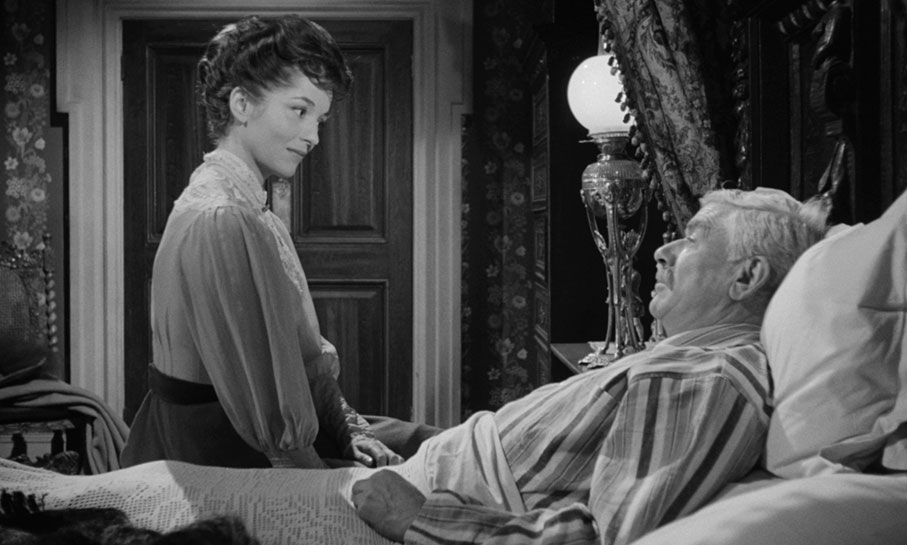
The Linear PCM 1.0 mono soundtrack has also been restored, and although has the sort of dynamic range restrictions that are normal for a British film of this vintage – something particularly evident in some of the dialogue and sound effects – it is otherwise clear and free of damage and background hiss, and Mikis Theodorakis’s score comes across well.
Optional English subtitles for the deaf and hearing impaired are available.
Audio Commentary with Bruce G. Hallenbeck
Long-time contributor to Little Shoppe of Horrors magazine, Bruce G. Hallenbeck, provides a consistently interesting commentary on a film he describes amusingly as “the ultimate cat-lovers movie.” We get information on the actors, the controversy over which company really produced the film (this is also covered elsewhere), director John Gilling, score composer Mikis Theodorakis, conflicting claims made by Gilling and writer George Baxt regarding the screenplay, the influence of Edgar Allan Poe, production designer Bernard Robinson, editor John Pomeroy, and a lot more. Almost everyone who appears on screen gets some coverage, as do many who worked behind the camera, and John Gilling’s reputation as a bully is also examined, with a few unflattering quotes from some of those who worked with him. “John Gilling may have been a pompous ass,” Hallenbeck concludes, “but he was also a terrific writer-director.”
Barbara Shelley: In the Shadow of Shelley (24:29)
An interview conducted by Calum Waddell with actor Barbara Shelley in what looks to be her final years, one in which her obvious physical frailty is negated by the sharpness of her memory and the stories she tells. She looks back at her early days making films in Italy, working with a live leopard on the 1957 Cat Girl, falling in love with Shakespeare’s writings when working with Donald Wolfit on Blood of the Vampire (1958), the filmmakers’ misguided decision to use fake snakes for her headdress in The Gorgon (1964), the joy of working with Peter Cushing and Christopher Lee, and plenty more. She cites Roy Ward Baker as her favourite director and her role in Quatermass and the Pit as the favourite of her films and notes that while she had to pay her own transport costs when working for Hammer, it had a truly wonderful canteen with great food. When the interview begins, I was thrown a little by the uncomfortable tightness of the framing, then realised that this was done to hide a medical dressing on Shelley’s forehead and that this was thus done out of respect for her dignity. Bravo.
Peter Allchorne and Yvonne Blake: Cat People (4:34)
A brief chat with props man Pater Allchorne and assistant costume designer Yvonne Blake, and when I say brief it’s worth noting that the running time above includes a few extracts from the film. Allchorne recalls Gilling being a strict and impatient director and tells of the problems they had getting the cat to do as directed, while Blake remembers enjoying her time on the film but next to nothing about the production itself, though she does reveal that only the lead actors would have their costumes specially designed and made.

Ian Scoones: Special FX Catastrophe (3:58)
A brief audio interview with Ian Scoones, who worked as effects assistant to Les Bowie on the film, conducted over the phone by Hammer expert Wayne Kinsey. Scoones recalls being given a bollocking by Gilling on his first day after making the very mistake he had just been warned to specifically avoid, and confirms a story told elsewhere about prompting the cat to jump on cue by giving it a small electric shock. Animal lovers will doubtless be delighted to learn that when this was delivered, that cat promptly emptied its bowels all over Bowie’s favourite coat and that he smelt so bad that no-one would go near him for days.
Hammer’s Women: Freda Jackson (9:05)
Here Lucy Bolton looks back at the career of actor Freda Jackson, from her early years performing Shakespeare on stage to her film work and memorable roles for Hammer in Brides of Dracula and Shadow of the Cat, as well as touching on her later work.
Introduction by Kim Newman (10:37)
Author, critic and genre devotee Kim Newman outlines how the film came to be and why it was Hammer’s only period gothic work to be shot in black-and-white. He also explores the career and filmmaking style of director John Gilling, the film’s lead players and supporting cast, its relatively simple story and its body-count structure. It’s billed as an introduction, but later plot developments are touched on and the illustrative clips include one from the film’s finale.
Catmotifs: Huckvale on Theodorakis (17:21)
The first of four presentations by David Huckvale, author of Hammer Film Scores and the Musical Avant-Garde, who here outlines the extraordinary background of Shadow of the Cat score composer Mikis Theodorakis, Greece’s most celebrated composer and a left-wing champion of freedom, who was tortured, exiled, and twice buried alive for his beliefs and activism. As ever, Huckvale deconstructs key elements of Theodorakis’s music for the film and reveals that the original score sold for £4,000 at Sotheby’s. He also opines that the cat is miscast because it is too cuddly. I’m not so sure…
Shadow Play: Inside ‘The Shadow of the Cat’ (25:31)
An examination of the film and its making, constructed from interviews with genre writers Jonathan Rigby, Alan Barnes, Denis Meikle and Marcus Hearne, plus some welcome contributions from André Morell’s son Jason. Some of the content here is also covered elsewhere to some degree (you’ll hear several times how the project came about), but there’s still plenty of interest, including the observation that the film’s heroine is unusual in that she is not menaced by its monster. Also discussed is director John Gilling and the film’s connection to his later Hammer work, The Mummy’s Shroud, and Hearne even presents physical evidence to settle the long-running argument over whether this really was a Hammer film.

Double-Bill TV Spot (1:01)
A fun black-and-white TV trailer for the double-bill of The Curse of the Werewolf and The Shadow of the Cat, the narration on which gives new meaning to the idea that a cat has nine lives.
Image Galleries
This is divided into two galleries. Production Stills has 23 screens of crisply rendered photos, including a couple of portraits and behind-the-scenes images, while in Promotional Material, we have 42 screens of press images, monochrome and acid-trip coloured lobby cards, press book pages, press clippings and posters.
Booklet
Following the expected credits for the film, this well illustrated, stand-alone booklet kicks off with a comprehensive essay by film scholar, writer, and researcher Craig Ian Mann, which does cover ground you’ll by now be familiar with if you watched the on-disc features first, but his comments on the film itself are still absolutely worth a read. This is followed by a selection pre-written promotional stories taken from the American pressbook, and a piece compiled from two interviews with actor Barbara Shelley conducted by Michael Doyle in the Spring of 2010. Finally, we have three contemporary reviews, including a single-line dismissal from Monthly Film Bulletin.
In 1776, on the pirate ship of the notorious Captain Clegg, a burly mixed-race crew member credited only as The Mulatto (which today would be about as sensitive of identifying an Italian crew member as The Wop) and played by Hammer irregular and former wrestler Milton Reid, is charged with attacking the captain’s wife. He is punished by having his ears slit and his tongue cut out, after which he left on a deserted island, tied to a post that carries a warning to others of the consequences of crossing Clegg. Once the main titles have concluded, we hop forward 16 years to 1792 and a small South-Eastern English town on the edge of the Romney Marshes, in whose church graveyard the now deceased Captain Clegg is buried. A narrated text crawl then tells of the smuggling that took place there in defiance of the King’s revenue men (true, as it happens) and of the legend of the Marsh Phantoms, which then make their appearance as luminous skeletal riders and horses, terrifying a man named Old Tom Ketch (Sydney Bromley), who dies of fright and falls into the marsh.
We then find ourselves in the local church as a congregation sings hymns under the energetic direction of parish priest, Dr. Blyss (Peter Cushing), who then chides them for not giving their all and reminds them that they have much to be grateful for, including the fact that they do not have any of the King’s soldiers billeted in their homes. Any suspicion that this might be a bit of foreshowing is then confirmed when a small boatload of the very same King’s men roll up at a not-too-distant wetland shore, having chosen this particular time because they know the whole town will be dutifully attending church. Well, not quite the whole town, as their arrival is observed by young Gerry (Rupert Osborn), who runs quietly to the top of a nearby hill and waves at a lookout stationed on the church roof. He signals below by jiggling the bell rope, which is spotted by choirmaster and local coffin maker Jeremiah Mipps (Michael Ripper), who discreetly tips the wink to local bar proprietor Rash (Martin Benson) before quietly taking his leave. Rash and a handful of others soon do likewise, something curiously not commented on by the no-nonsense Blyss.
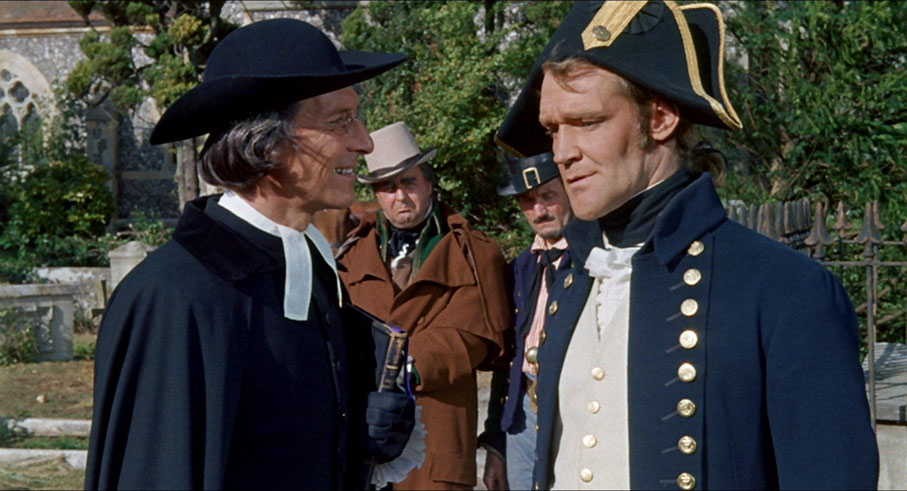
While Captain Collier (Patrick Allen) pays a curt courtesy visit the church, his men investigate the bar in which they have been told they will find smuggled liquor, but Mipps and Rash are by then ready and waiting for them. Connections to earlier scenes then start to emerge. It turns out that the man who tipped off Collier about the booze is the very same Tom Ketch we saw frightened to death in the post-title sequence, and when Collier’s men are unable to find any trace of the illicit liquor for which they are searching, they bring out their secret weapon in the shape of the now tongueless Mulatto from the opening scene. The poor fellow was rescued by Collier and is now held captive by him and used as a sniffer dog, given a whiff of a wine bottle and then sent scurrying around on all fours to locate the cellar in which, of course, there is now no trace of smuggled liquor. As the ever-smiling Mipps takes Collier to meet the corpse of the man he was unaware had died, Rash slips through a secret door and down a passage that leads him into Mipps’ basement workshop, where villagers are unpacking coffins full of illicit booze. It’s after Mipps has successfully sent the frustrated Collier on his way that the leader of this smuggling operation appears, and lo and behold it’s the good Reverend Blyss, who proves to be even more authoritative as a gang boss than his is as a man of God.
Okay, we’ve now reached that moment that you’ll find in a fair few of my recent reviews where I feel the need to throw up a spoiler warning for those looking to go into the film knowing as little as possible about how the plot unfolds. Whether what I’m planning to discuss will count as a major or minor spoiler will depend on how quickly the penny drops for the individual viewer, but the first real clue is such a whopper that I’m guessing not just that most will work it out in an instant, but also that the filmmakers fully intended that we should do so. But if you want to bypass that little discussion, skip the following paragraph, or click here to do so automatically.
As the King’s men install themselves in the town and continue their search for smuggled booze and the Blyss team continue to transport contraband behind their backs, something unexpected happens. The Mulatto is enjoying a rare moment of booze-assisted recreation when he and Blyss suddenly catch sight of each other – Blyss is startled, and on seeing the good Reverend, the Mulatto becomes enraged and tries to kill him. Seriously, can there be anyone watching who doesn’t twig what this infers? This supposition is seemingly confirmed by the drip-feed of further clues that follow and the lack of a big revelatory moment when confirmation does eventually arrive. The story thus becomes less about whether Blyss might really be Clegg than about when and how this secret will be discovered by Collier, and what action he will take. A case is made in the special features that the Clegg of the prologue is a thoroughly nasty piece of work, but I’d argue that it’s not so cut and dried. He’s ruthless, sure, but the opening line of dialogue suggests that the unpleasant punishment dished out to the Mulatto is not a random act of vengeance on Clegg’s part, but one specifically outlined in the pirate code by which they all have chosen to live, and the crime itself is not some trivial breach of etiquette but the attempted murder of Clegg’s wife. How would you react if a sizeable brute had violently assaulted your nearest and dearest? Once you suss that Blyss and Clegg are very likely one and the same, it also makes complete sense that he would not only take charge of the smuggling operation but would have the required knowledge, experience, and international contacts to set it up in the first place. The likelihood that his posing as Blyss is just a cover for his smuggling also takes a dent or two when it’s revealed that he has been using the resulting profits to improve the lives of his partitioners and rebuild the town, which raises some interesting questions regarding what transformed him from the pirate he once was into the man he has become.
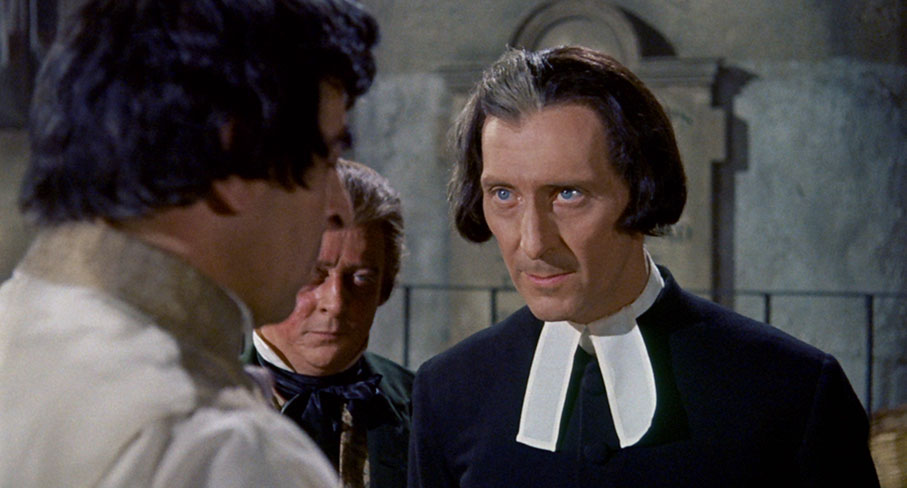
Peter Cushing is at his formidable best as Blyss, a role that he researched and threw himself into so completely that he wrote his own version of the script and even created watercolour paintings of how he thought his character should look. And he really is superb here, completely committed whether delivering a sermon and encouraging his parishioners to sing with more gusto or giving out orders and sharply reminding Rash just who is in command of their little enterprise. In one of several supporting roles that he played for Hammer around this time, Oliver Reed plays Harry Cobtree, the son of local Squire Anthony Cobtree (Derek Francis) and the film’s young romantic lead. At first, Reed’s gift for underscoring even casual glances with a whiff of danger makes him seem like an odd choice for such a role, but his sheer skill as an actor soon pays dividends. This really shows in the dinner table story he tells about having once seen the Marsh Phantoms, and when he later attempts to escape the clutches of Collier’s men, where the physicality of his performance sells Harry’s desperation as real. Learning that he played this entire scene with a broken shoulder after refusing to go to hospital following a car crash until his work for the day was complete only deepened my respect for his commitment to the role. Elsewhere, there is solid support from Martin Benson as innkeeper Rash, the weak link in the smuggling team who graduates to despicable when he attempts to rape Harry’s barmaid girlfriend, Imogene (Yvonne Romain), and the ever-reliable David Lodge as the unnamed ship’s Bosun. But shining brightest in support and even giving Cushing a run for his money is Hammer stalwart Michael Ripper as coffin maker Jeremiah Mipps in what may well be his finest role for the studio. From the subtle signal he sends to Rash as he exits the church to the gloriously self-confident smiles he wears like a treasured hat when dealing with Collier and his men, he’s an absolute joy to watch at work here, and is later given the opportunity to show his full range when he movingly responds to a personal tragedy.
Confidently directed by Peter Graham Scott, an occasional feature director who worked primarily in television, and featuring handsome cinematography, production design and effects and matte work by Hammer favourites Arthur Grant, Bernard Robinson and Les Bowie respectively, it’s a far more entertaining and robust tale than its unfortunately age-neutered title might suggest. The screenplay by Anthony Hinds (under his usual pseudonym of John Elder), with additional dialogue by Barbara S. Harper, also has its moments. My favourite comes when the sailors are living it up in the town’s bar, and as young Gerry is delivering drinks to a table, he spies a noose tattoo on a seaman’s arm. “I can tie that knot!” he confidently claims. “Want to be a sailor when you grows up, eh?” the seaman asks, to which Gerry enthusiastically responds, “No, I’m going to be ‘angman,” then adding as he wrenches the seaman’s neckerchief skyward, “I’ll string ‘em up…and cut ‘em down!” The Bosun then leans over and says to Gerry, “We may have business for you, boy, before we finish here.”
Sourced from a Universal HD remaster, the 1.85:1, 1080p transfer here is once again impressive, with handsome colour reproduction and a vibrant rendition of the primes, albeit with that familiar hue that's sometimes evident on Eastmancolor films of the period. Detail is crisp and the contrast nicely balanced with solid black levels, and the image is clean and stable with a visible fine film grain.
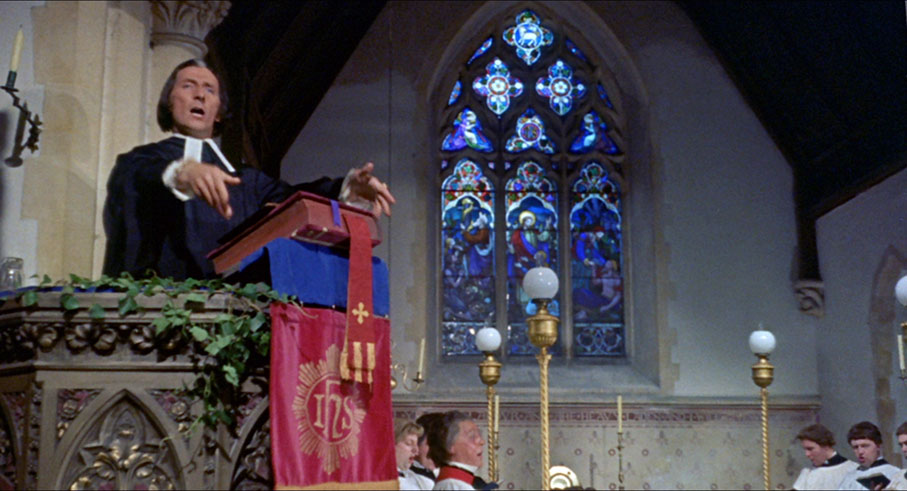
The only film in this set not to have a Linear PCM soundtrack instead has a DTS-HD Master Audio 1.0 mono track instead. There are the expected age-related range restrictions, but all is otherwise clear and free of obvious wear.
Optional English subtitles are again available for the deaf and hearing impaired.
When you elect to play the film, you are offered the choice of watching it either under its original British title of Captain Clegg or its American release title of Night Creatures. Apart from the opening title text, there appear to be no differences between the two.
Audio Commentary with Constantine Nasr
Filmmaker and historian Constantine Nasr delivers a busy and informative commentary on this highly regarded Hammer production. He covers a lot of ground, identifying footage borrowed from David Lean’s Great Expectations and providing details on the church location (there are plenty of quotes from director Peter Graham Scott about this), Peter Cushing’s research for a role he was deeply committed to, how the film came about (you’ll hear this again, but not with this level of detail), and the accident that saw Oliver Reed perform scenes with a broken shoulder. Extracts from the alternative script written by Cushing are read, and there’s info on locations, the colour timing of this transfer, the cast and crew, and the source material. Nasr also praises what he describes as one of Michael Ripper’s most rewarding roles. This is just a sampling. Good stuff.
The BEHP Interview with Peter Graham Scott (3:20:46)
We’ve seen a fair few of the interviews with filmmakers conducted for the British Entertainment History Project make their way onto Indicator Blu-ray releases as special features, but none of the epic length of this one with director, writer and editor, Peter Graham Scott, which was conducted on 23 July 2004. If you’re intending to watch this then you need to plan ahead, because it runs for a whopping 3 hours and 21 minutes, and being a whole evening’s viewing for me, it was one of the extras that delayed the completion and posting of this review. As you’d expect, there’s a lot to get your teeth into here, as Graham Scott – prompted occasionally by interviewers Darrol Blake and John Sealey – takes us on a trip through his entire film and television career, often in detail and peppered with interesting and occasionally amusing stories. The man has had a fascinating career that has taken him all over the world, although this nearly turned sour when he found himself filming in Beirut just as the 7-Day War was about to erupt. His stories of his first feature editing job on Brighton Rock are of particular interest, especially what he learned from producer Roy Boulting, whom he regards as one of the world’s greatest editors. Given the disc this is on, I was all geared up for what he had to say about Captain Clegg, but after remarking on the high regard in which it is now held and telling a story that you’ll hear elsewhere about how his good friend and producer John Temple Smith found a Romney Marsh stand-in location at a nearby gravel pit, he moves quickly on. Still absolutely worth a watch for the sheer volume of information contained within.
Hammer’s Women: Arbuthnot and Burrows (13:47)
Ever-knowledgeable film historian Josephine Botting breaks from the usual focus on actors to examine the work and careers of wardrobe supervisor Molly Arbuthnot and her eventual assistant, Rosemary Burrows. The process and practicalities of selecting and designing costumes is covered, and there is some specific information on their work on Captain Clegg.

Introduction by Kim Newman (13:55)
Here, Mr. Newman talks about the Dr. Syn novels from which the film was drawn, the rights issues caused when they were bought up by Disney, Cushing’s commitment to the lead role and his alternative screenplay, the film’s pairing with The Phantom of the Opera for its British cinema release, and the suggestion that both would have done better business had they had more ‘X’ certificate content. I was particularly amused by his comments on one Hammer project that was ultimately cancelled due pressure from the BBFC, where he says in smiling frustration, “I occasionally want to go down to Soho Square and throw rocks through their window because I feel personally aggrieved that we were cheated out of a Richard Matheson scripted version of I Am Legend made by Hammer Films in the late 50s.” Need any help with that?
Peter Cushing: Perspectives (28:59)
A documentary portrait of Peter Cushing by Peter Cushing: In His Own Words director Richard Edwards, one that plays a little like the sort of tribute piece that airs just after a widely beloved media figure has died. It’s perhaps not surprising that Cushing’s close friends and colleagues are not interviewed, given that many have also passed on, so instead we have actor and enthusiastic fan of Cushing’s work, Derek Fowlds, who died last year, Hammer runners Bryan Reynolds and Phil Campbell, film historians and authors Morris Bright and Paul Welsh, and actors Judy Matheson and Madeline Smith, who worked with Cushing on Twins of Evil and Frankenstein and the Monster from Hell respectively. That Cushing was one of the nicest men and best prepared actors to work with should be old news to anyone who has read about or heard others talk about him in the past, and you’ll hear it a lot in this piece.
Smugglers’ Gothic: Huckvale on Banks and Martell (21:21)
David Huckvale is back to look at the careers of Captain Clegg score composer Don Banks and musical director Phil Martell, before once again deconstructing the score and examining the main themes and the purpose to which they are put. There’s info on Banks’ relationship with Hammer’s resident musical supervisor, Philip Martell, and acknowledgement of the influence of Miklós Rózsa and Erich Wolfgang Korngold on the score for what Huckvale neatly describes as a gothic swashbuckler.
Making of ‘Captain Clegg’ (32:00)
A straightforward but interesting look at the making of the film, produced and directed by Jim Groom & Don Fearney, narrated by John Carson, and written and introduced by Wayne Kinsey, who also features in the following extra. There is some rather neat stuff here, including brief coverage of all the Dr. Syn novels, complete with book covers, plus shots of Cushing’s own proposed treatment for the film and even the watercolour drawings he created of his character. The story of how Oliver Reed was injured in a car accident during the filming but carried on working with what turned out to be a broken shoulder says a lot about his early career professionalism, and it’s nice to see Peter Cushing and Michael Ripper singled out for the quality of their performances.
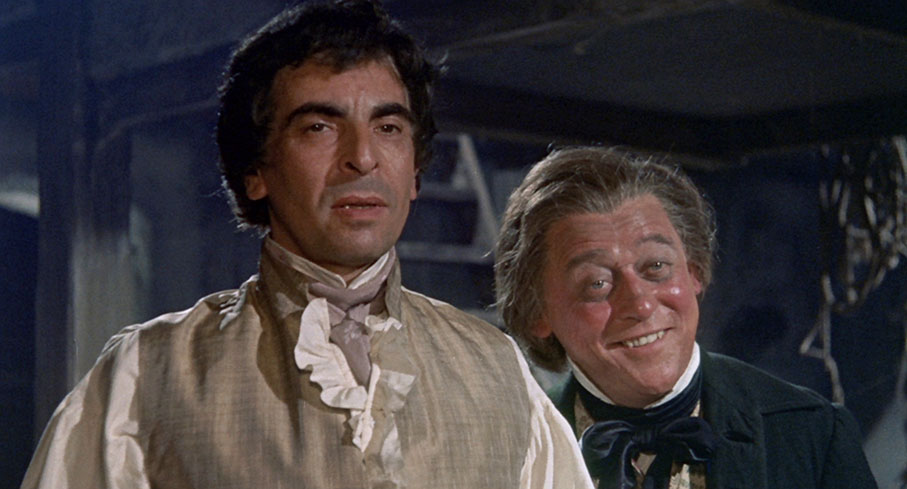
The Mossman Legacy (6:53)
Hammer guru Wayne Kinsey takes us on a tour of the various horse-drawn carriages collected by George Mossman, identifying which Hammer films each of them was used in. Of mild interest, and with a running time that prevents it wearing out its welcome.
‘Night Creatures’ Theatrical Trailer (1:01)
A colour-drained trailer for the film under its American title with the usual over-dramatic narration that includes the technically accurate but still amusing line, “Funerals move under the cloak of night, but nobody enquires who has died, if, indeed, anyone has,” and describes the film as “a fascinating adventure in horror.” Fair enough.
Again, we have two Image Galleries, starting with a generous 104 Production Stills which include a generous collection of posed portraits and behind-the-scenes photos, my favourite of which has Collier and his men in full period costume standing at a (then) modern bus stop. There are also some images of Peter Cushing being coached by the priest who acted as adviser on the film. Promotional Material has 88 screens of international lobby cards, press book pages, press clippings, and posters, including one promoting the film’s teaming with The Phantom of the Opera.
Booklet
The lead essay in here is by freelance film and television writer and researcher, Frank Collins, who looks at the development of the story from novel to film and once again visits ground also covered in the on-disc extras, though does include a few details that were new to me, and this still makes for a most interesting read. A second piece on the film and its star by Kieran Foster has less in the way of new information but is still a solid read. A whole slew of entertaining extracts from the film’s pressbook follows, which includes the invitation to make as many words as possible of three or more letters from the title, Captain Clegg. The best one I could come up with on the fly was ‘paginate’, probably because it’s one I use almost every day in my day job. A short piece about the in-film wedding ceremony from the American Night Creatures pressbook is followed by three examples of contemporary critical response. Few will be surprised that the unnamed Monthly Film Bulletin reviewer was not remotely impressed.
| THE PHANTOM OF THE OPERA (1962) |
|
I must confess that of all the classic monsters, the Phantom of the Opera is the only one that I never really engaged with in my formative years. I’m not sure why. Many years later, it seemed only appropriate that of all the horror stories of old, this was the one that Andrew Lloyd Webber and his cohorts would turn into the sort of crowd-pleasing stage musical I’d run a mile on my seriously gammy foot to avoid sitting through again. As I escaped my teens and expanded my cinematic horizons, The Phantom remained tucked away as someone to revisit in one of his many guises someday, when I had a moment. There were exceptions. A ropey print of the 1925 silent take on the film piqued my interest on the basis of Lon Chaney’s extraordinary makeup alone, and given that it’s been available on Blu-ray in a Dual Format edition from the BFI since 2003, I really ought to give it another, clearer look. Then there was Brian De Palma’s 1974 rock musical update of the tale, The Phantom of the Paradise, which I first caught at the National Film Theatre in a season of films by the so-called Movie Brats and found hugely entertaining in the way that later stage musical version was not. But De Palma’s was a revisionist take on a tale that I still couldn’t get that fired-up about, and had thus convinced myself in advance that this 1962 Hammer version was going to be the one film in this set that I was going to sit patiently through and say a few middling words about before moving on. Oh, do you think so, eh?

I’m guessing that even if you’ve never see seen this film then you know the bare bones of Gaston Leroux’s original story, but here such foreknowledge will only get you so far. As with Captain Clegg, with which this film was partnered on release, the script was written by producer Anthony Hinds (once again as John Elder), and as was common with Hammer takes on famous gothic novels, he uses the original story as a foundation on which to build something new. Faithful to the source in many ways, it also alters the thrust of the tale to create a more sympathetic Phantom and an altogether different and more dislikeable villain.
It’s London in November of 1900 and the opening night of The Tragedy of Joan of Arc,* a new opera by respected composer, Lord Ambrose D’Arcy (Michael Gough). The orchestra is tuning up and the show’s Italian diva Maria (Liane Aukin) is practicing her scales in her dressing room when a badly scarred hand turns down the gaslight. By the time the show’s producer, Harry Hunter (Edward de Souza), arrives, Maria has locked herself in her room and is refusing to come out. When Harry knocks she urgently admits him and reveals that she was visited by a figure dressed from head to foot in black and who stared at her with a single eye. Quite why she’s barricaded herself in the very room in which this happened instead of fleeing from it is anybody’s guess. Anyway, Harry, in the way men have of casually dismissing women’s fears in genre films, tells her that he’s sure she saw something but insists that she should go stage on tonight regardless, despite her strong reluctance to do so. This is not the only ominous sign that Harry fails to recognise as such. When he arrived, the poster outside the theatre had been torn apart, and orchestra conductor Rossi (Martin Miller) is complaining that some of the pages of his score have gone missing. And when D’Arcy himself arrives and takes his seat in a box with forelock-tugging theatre manager Lattimer (Thorley Walters), he questions why the box opposite is empty when they have a full house, and Lattimer reveals that people are reluctant to sit there after hearing voices. What could be the cause?
By this point the opera is in full flow, but when Maria takes the stage, she is watched from above by a hunched figure, and the production is brought to a sudden and alarming halt when the hanged body of a production technician swings onto the stage. Maria sharply quits and refuses to ever sing in this country again, so Harry starts auditioning for a replacement. This infuriates D’Arcy, who thus storms down to the auditorium, where the dressing-down he starts giving to Harry is silenced by the angelic voice of the current performer, Christine Charles (Heather Sears). Surprisingly, both men appear to quickly agree that they’ve found their new Joan of Arc. D’Arcy, however, clearly also has more salacious designs on the pretty Christine and invites her to dinner with the intention of getting her tipsy and taking her back to his place. As Christine is preparing in the dressing room, however, a hidden voice commends her on her singing but insists that she will sing better and that he will teach her how, but also that she will sing only for him.
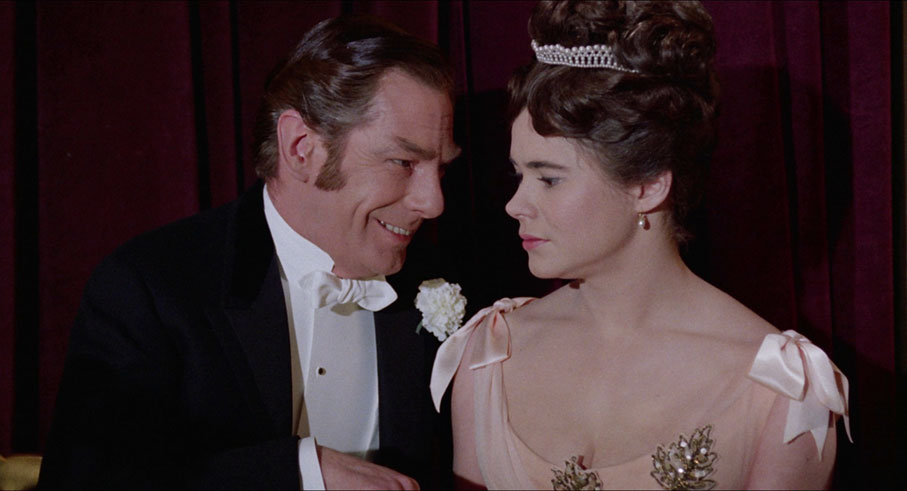
The essentials of the original story are certainly in place here, albeit in a sometimes-altered form with characters that are specific to this film interpretation. Harry is a stand-in for the original’s Vicomte Raoul de Chagny, while Lord Ambrose D’Arcy is a purely Hinds invention, and a rather splendid one. As played by Michael Gough, who was a little ineffectual as the romantic male lead in Hammer’s superb 1958 take on Dracula, D’Arcy is an instantly dislikeable creature who quickly evolves into a detestable one, and I mean that as a compliment of the highest order. Pompously arrogant from the off, his sleazy advances to the innocent Christine at dinner genuinely had me worried for the poor girl’s fate, at least until Harry demonstrates an uncanny knack for timing by walking into the very same upmarket restaurant. As the film progresses, D’Arcy’s ego inflates to Hindenburg proportions and he starts angrily firing anyone who dares to talk back to him, and it thus feels logical that he is in some way connected to the creature who seems to haunt this theatre.
As Harry, Edward de Souza makes for a lively romantic male lead and is well paired with Heather Sears as Christine, who does a nice line in uncertain innocence and, in the tradition of such films, falls for Harry at unlikely but narratively economical speed. Playing the Phantom and getting top billing for the role is the always enjoyable Herbert Lom, who by this point in his distinguished career had already made his mark in films such as The Ladykillers, Hell Drivers and Mysterious Island, and yet here, save for a lengthy flashback that is shot entirely in Dutch tilt angles, his face remains as hidden as that of Claude Rains in James Whale’s The Invisible Man. Initially only a voice in the dressing room – and a quite wonderful one – his mask is not the slickly crafted one you’ll find on West End musical posters but an intriguingly rough-and-ready creation, one you really can believe he crafted himself from whatever materials he could scavenge. New to this interpretation is the Phantom’s diminutive assistant, who is credited simply as The Dwarf (Ian Wilson), a man whose primary role is to commit the dastardlier acts that would usually be carried out by the Phantom and thus allow his master to remain a sympathetic victim of circumstance and the malice of others. And keep an eye on the small supporting roles, which include Hammer regulars Miles Malleson and a heavily made-up Michael Ripper as cabbies, Marne Maitland as a restaurant waiter, and later Dr. Who and Dracula manservant Patrick Troughton as a cockney ratcatcher.
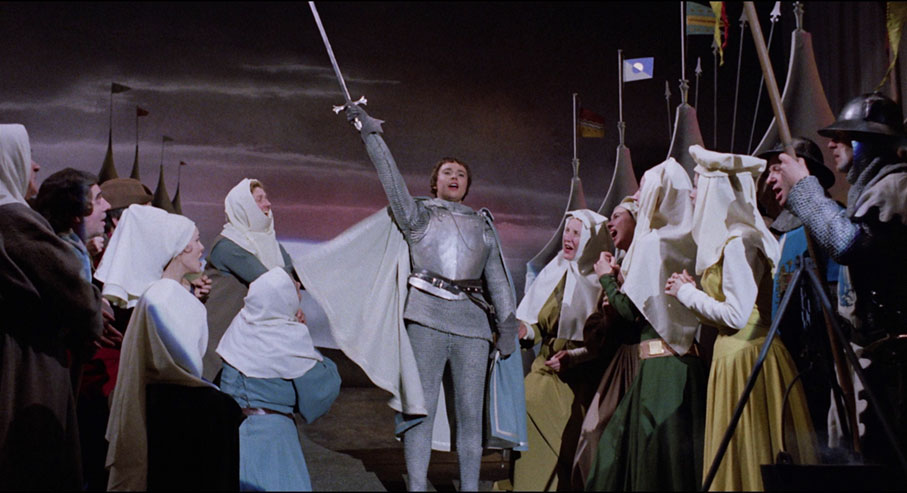
I really was surprised by how much I enjoyed this distinctive take on a story I had somehow previously failed to engage with. Although credited as Hammer’s most expensive production, it’s still by any normal standard a low-budget work, yet it has a sense of scale that is rare for the studio’s output of the period, with the real-life Wimbledon Theatre interior standing in for the London Opera House and a several segments from composer Edwin Astley’s in-film opera performed with gusto. The Phantom’s underground lair is also given a sense of operatic grandeur by Hammer’s production design wizard, Bernard Robinson,studio maestro Terence Fisher keeps the action moving at a lick and the story focussed on the characters, and the whole thing is vibrantly photographed in lush Eastmancolor by studio regular Arthur Grant. Those expecting an all-out horror take on the story may be disappointed, despite a belter of a shock moment when the hanged stagehand swings straight into the camera and a cautiously angled but still unpleasant eye stabbing, and I know I’m not the only one who was surprised that the villain doesn’t get the comeuppance that he truly deserves. Yet what is most intriguing about this toning-down of the Hammer horror formula is that it appears to have been driven primarily by a tailoring of the project to suit none other than Cary Grant, an apparent fan of Hammer’s work who had expressed an interest in starring in one of their films. Speaking personally, I’m happy with the cast as it is, but can you imagine?
Sourced from a 2K restoration by Shout! Factory from the film’s interpositive and delivered by Universal, this is another fine 1080p transfer with nicely balanced contrast when the light levels are strong, but which feels just a whisper more aggressive in darker scenes, where some picture information can be swallowed by the beefy black levels. The detail is very clearly defined, though it does soften just a tad in a couple of shots and suffers an early dip in a short early exterior shot of the theatre. The image is again clean and damage-free with a fine film grain visible, and the colours of costumes and stage sets are handsomely rendered.
There is an option to play the film in its original aspect ratio of 1.66:1 or its more commonly projected ratio of 1.85:1. As a purist, I opted for the former, but skimming through a few scenes on 1.85:1, which clips the very top and bottom of the 1.66:1 frame, I saw no shots in which the image felt uncomfortably cramped, and it seems likely the film was shot with the full expectation that this reframing would occur.
The Linear PCM 1.0 mono soundtrack again has a few range restrictions but is sonically one of the strongest films here, with clear dialogue and solid reproduction of the music and stage performances. The Phantom’s organ playing of Bach’s Toccata sounds particularly good.
Optional English subtitles for the deaf and hearing impaired are available.
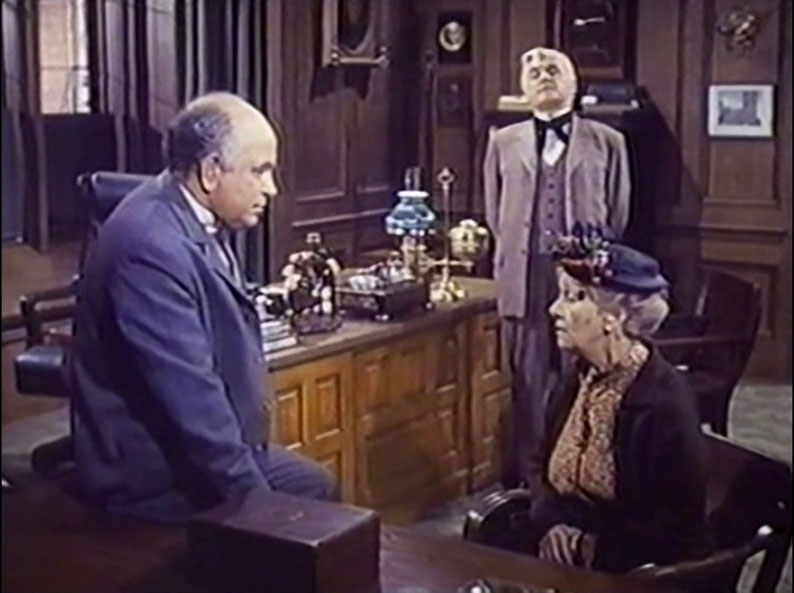
Also included is the option to play the American TV cut of the film, which contrary to expectations is not a cut-down version but one that is over 13 minutes longer than the theatrical release. This cut was created for the film’s first US TV screening, with additional footage shot by NBC in Los Angeles, primarily using locally based British and Irish actors playing characters that are unique to this extra material. Four of the new scenes involve a subplot involving a Scotland Yard investigation into the nefarious goings-on at the theatre, which is being carried out by dull but workmanlike Inspector Wyatt, played solidly enough by Liam Redmond, and his pompous twerp of a colleague, Inspector Dawson, colourfully overacted by John Maddison. In a fifth scene, the Dwarf attacks D’Arcy’s latest protégé in her bedroom, from which she manages to successfully flee, which is shot with both characters’ faces hidden in shadow to disguise the fact that these are substitute actors.
Unsurprisingly, this new footage adds nothing to a film that worked fine without it, breaking the narrative flow, and disrupting the visual continuity with Scotland Yard sequences that are lit and shot like an American TV movie of the day. The detectives ultimately serve no purpose whatsoever, overexplaining plot points that were perfectly clear anyway and whose scenes thus feel like the padding they are, something particularly true of the ‘Black Museum’ sequence. In the same vein, one sequence from the original film has also been repurposed here as a flashback to hammer home (no pun intended) an already evident plot point for the more slow-witted audience members. And despite being one of Hammer’s rare ‘A’ certificate films from the period, the moment when one character is stabbed in the eye has been censored, despite it having been shot in a way that suggests something that is not actually seen.
The rarity of this version makes it unsurprising that the print included here has been sourced from a standard definition, 4:3-framed home video recording, and thus it looks a bit rough. Impressively, it also has optional subtitles for the deaf and hearing impaired.
Audio Commentary with Steve Haberman and Constantine Nasr
The first of two commentary tracks that accompany The Phantom of the Opera features author Steve Haberman and film historian Constantine Nasr, who plant their flag early by claiming that this is a very misunderstood film, then proceed to make a solid case for that proclamation. Haberman in particular sees it as a Faustian allegory with D’Arcy as the Devil, and both are brimming with information on the actors, the filmmakers and the production, including a story you’ll hear often about how the project was originally set to star Cary Grant. They identify lines of dialogue that weren’t in the script, compare the lighting styles of Hammer cinematographers Jack Asher and Arthur Grant, take issue with the common criticism of final act, and lament that the film has not been as highly praised as it deserves to be, particularly considering that it was one of director Terence Fisher’s favourites of his own films for Hammer. I was also amused by the claim – or should that be the observation – that no-one plays British snivelling like Michael Gough. There’s lots more here, all of it worthwhile.
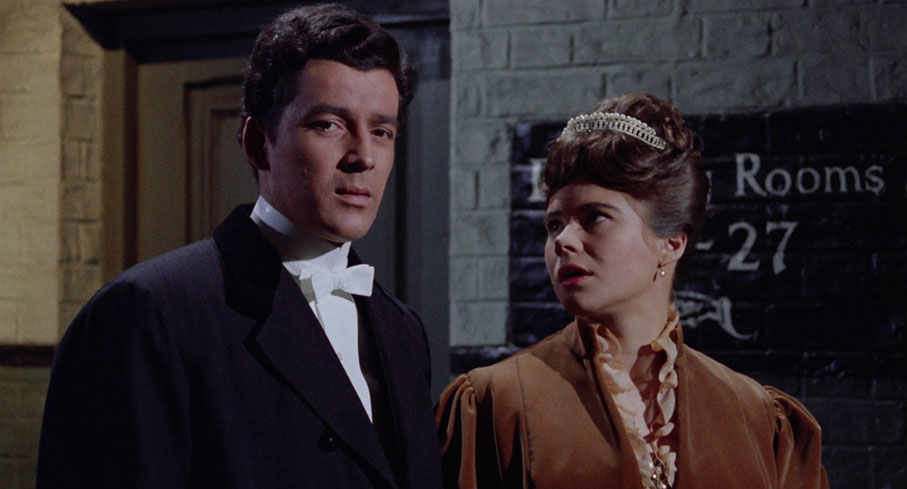
Audio Commentary with Troy Howarth and Nathaniel Thompson
This second commentary with film historians Troy Howarth and Nathaniel Thompson does inevitably cover some of the same ground as Haberman and Nasr – the Cary Grant story and comparisons between the lighting styles of Hammer regulars Jack Asher and Arthur Grant included – but there’s more than enough that is unique to this track to justify its inclusion. Even when there is crossover, the stories are told from an alternative viewpoint, something especially evident when they get to the film’s final act, which Haberman finds unsatisfying but Thompson praises for its unorthodoxy. Despite this, Haberman still regards Herbert Lom as his favourite Phantom and this film as his favourite adaptation of the Gaston Leroux novel, and both men clearly hold it in very high regard.
Brian Johnson: Down in the Sewers (5:58)
Special effects assistant Brian Johnson looks back at what he remembers was a very enjoyable film to work on, and recalls the magnificent sets built by Bernard Robinson and his team for next to no money, the tricks played by director Terence Fisher on assistant director, John Peverall, and a sequence involving live rats in which the animals ran amok and had those watching from what they falsely believed was the safety of the gallery screaming.
Hammer’s Women: Liane Aukin (6:18)
Academic Rachel Knightley provides a brief but eye-opening look at the life and work of Liane Aukin, who plays Maria, the opera singer who is traumatised into abandoning British productions completely by the hanged man in the film’s first act. Although she began as a theatre performer, she eventually abandoned acting altogether as “too passive” and took to writing (her credits include 18 episodes of EastEnders), political activism (she was co-editor of the anti-nuclear protest publication, The Greenham Factor) and eventually became a practicing psychotherapist.
Introduction by Kim Newman (12:18)
Kim Newman begins this introduction by setting the scene for the film’s making and touching on earlier film adaptations of the story, then discusses the tailoring of the script for Cary Grant, the effectiveness of Edward De Souza as the romantic lead and Michael Gough as the villain, the film’s influence, director Terence Fisher and more. Once again, good stuff.
The Men Who Made Hammer: Anthony Hinds (27:44)
Richard Klemensen, the editor and publisher of Little Shoppe of Horrors magazine, takes us on a comprehensive trip through the career of Hammer producer and eventual screenwriter, Anthony Hinds. Working chronologically from the formation of Hammer through the studio’s international success with the gothic horrors to Hinds’ eventual departure, most of this will be familiar to those who know their Hammer history, but would be an ideal primer for newcomers. Despite the many books I’ve read and documentaries I’ve watched about the studio, I was still rather delighted to learn that Hinds once told Klemensen, “Often times we wanted the heroes to be upper-class aristocratic shits. We wanted Frankenstein, the Baron, to be a shit.”
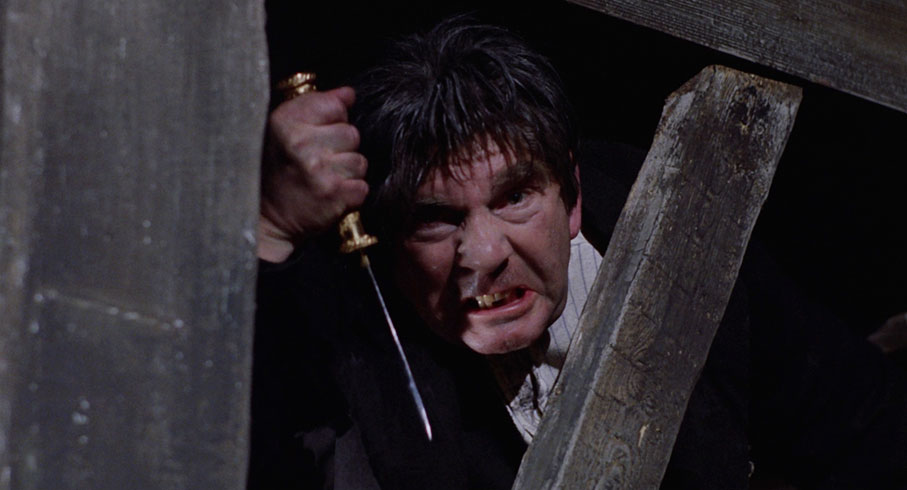
Phantom Triumphant: Edwin Astley and Hammer’s Horror Opera (15:47)
David Huckvale returns to examine composer Edwin Astley’s score, which includes extracts from a specially composed opera, a component that Huckvale links to other films with a similar musical requirement and describes as ‘potted concertos’. We get information on three of Astley’s most widely known TV show themes – Danger Man, Department S and The Saint – a tale about Hammer’s musical director Philip Martell that echoes a story thread in the film, and an explanation of something that is apparently known as ‘the Clapham Junction chord’, which I found fascinating. As ever, there is a breakdown of key elements of the score for this film, and I was pleased to note that I wasn’t the only one to recognise the opera piece whose opening notes pre-empt John Williams’ iconic main theme for Jaws.
Herbert Lom: The Soul Behind the Mask (15:28)
Screenwriter and novelist C. Courtney Joyner presents a very personal appreciation of actor Herbert Lom, whom he first met at a party and ended up talking to at some length, even later helping to edit his first novel, Dr. Guillotine. A quick trip through Lom’s early career, including his wartime work on radio broadcasts for producer Harry Alan Towers, lands us at Captain Nemo in Mysterious Island, which Joyner compares to James Mason’s interpretation of the role in 20,000 Leagues Under the Sea and that Lom apparently loved doing. Pleasingly, there’s plenty on The Phantom of the Opera, including the revelation that Lom wanted the rot of the sewer to be reflected in his costume and makeup. And yes, his role as the increasingly demented Chief Inspector Dreyfus in the Pink Panther films does get a mention.
Making of ‘The Phantom of the Opera’ (31:01)
Presented and narrated by Edward De Souza, who plays Harry Hunter in The Phantom of the Opera, this look back at the making of the film may be peppered with information you’ll likely have heard elsewhere by this point, but there are still personal stories that are unique to this featurette. Also contributing here are historian Richard Golen and Hammer sound recordist Alan Lavender, and considering this begins with the earlier film adaptations of the story and covers the production and release of the Hammer version, it does make for a useful introduction if you’re looking for a starting point in the special features and are struggling to find time for the two commentary tracks. That said, the decision to have De Souza talk about himself in the third person as the narrator and then cut to reflections on the making of the film as an interviewee is one I never felt particularly comfortable with.
Theatrical Trailers
In the UK Trailer (2:02), “In the shadows lurks a monstrous evil” is just one of the overstated claims made by the narrator an otherwise solid enough sell. In the US Trailer (1:16), that monstrous evil has been elevated to an “unspeakable terror,” whilst the production of an opera is trivialised as “gaiety and make-believe.” Otherwise, this takes its cues from the UK trailer.
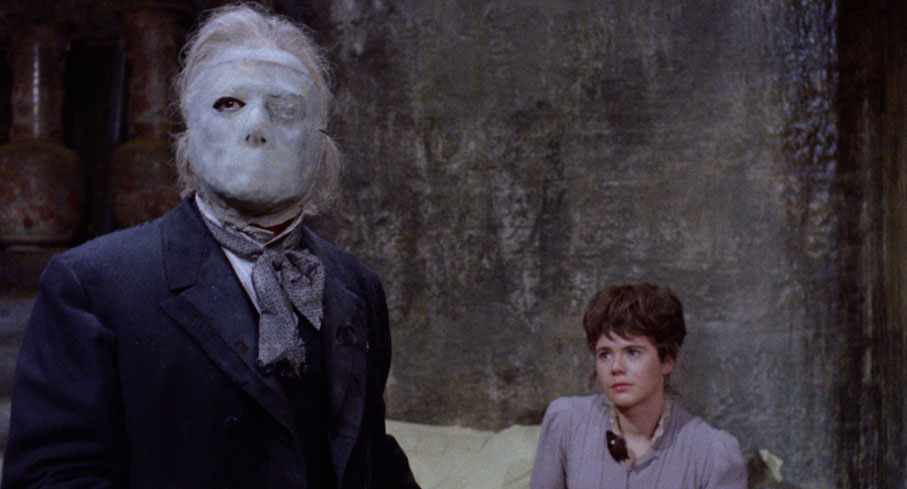
Brian Trenchard-Smith Trailer Commentary (3:07)
Filmmaker Brian Trenchard-Smith covers what is by this point well-worn territory in a Trailers From Hell commentary, though does describe Michael Gough’s D’Arcy, in one of those ‘I wish I’d said that’ comments, as “a splendidly reptilian villain.”
Image Galleries
Production Stills contains 47 slides of promotional stills, portraits and behind-the-scenes photos, while Promotional Material has a whopping 74 screens of coloured-in lobby cards, press book pages, press clippings, promotional suggestions, concept artwork and international posters.
Booklet
Following the credits for the film, this booklet opens with an essay by writer and filmmaker Adam Scovell, who concisely charts the development and specific appeal of this Hammer adaptation of Leroux’s original story. Extracts from the American pressbook, which include headlines like “Lom takes it on the lam,” are followed by a short extract from an interview with Terence Fisher by Jan Van Genechten in which the director talks briefly about the film, as well as touching on some of his other work for Hammer. Up next are some suggestions for promoting the film from its British and American pressbooks, which include initially bemusing ideas like “On your theatre screen for a sock pre-opening sales job!” and “TV telop or slide.” There’s also a suggestion for a midnight screening stunt that just reeks of the archaic sexual politics of the day – pleasingly, there is apparently no evidence that anyone took the distributor up on its offer. The expected sampling from contemporary critical reviews include a surprisingly complimentary one from Monthly Film Bulletin and a slightly less enthusiastic one from Variety.
It’s always interesting when a film makes good on its title in the opening scene. Here, teenage Janet (Jennie Linden) finds herself walking the dark corridors of an asylum and being drawn towards a specific cell by a female voice that is calling for her help. When she enters the cell in question, the owner of the voice emerges from the gloom to face her and the cell door slams shut, trapping the terrified Janet with the woman, whose previously despairing expression transforms into a demented grin. “Now they’ve got us both” she says. “It’s how it should be, isn’t it? We’re both mad, aren’t we. We’re both mad!” As the woman laughs maniacally, Janet bangs on the door and screams for help, screams that continue as she awakens from what turns out to be a recurring nightmare, and is only eventually calmed by her teacher, Mary Lewis (Brenda Bruce).

Janet is a pupil at Hatcher’s School for Young Ladies, which proves to be exactly what that name suggests, a boarding school to which the overprivileged send their offspring for the sort of education that installs in them the belief that they’re somehow better than the rest of us plebs. What, you thought you’d make it through this long review without me sneaking in a political dig? Be serious. With Janet unpopular with the other students, none of whom want to share a dorm with a girl who regularly awakes screaming from the same nightmare, the school decides that the best thing would be for her to return home. With her legal guardian, lawyer Henry Baxter (David Knight), unable to collect her and a long train journey ahead, Mary agrees to accompany Janet, and the two are met at the station by family chauffeur, John (George A. Cooper), whom Janet is clearly pleased to see. On the journey to the house, they pass an establishment that is surrounded by a high brick wall, and Janet orders John to stop the car, but he resists doing so and is only able to continue the journey thanks to Mary’s intervention. From the off-key strings of Don Banks’ score alone, it’s not hard to deduce what this establishment might be.
At the house, Janet and housekeeper Mrs. Gibbs (Irene Richmond) are overjoyed to see each other, but Janet is initially startled by the unexpected appearance of Grace Maddox (Moira Redmond), who it turns out has been hired by Henry to serve as a companion for her until he is able to return from the city. Janet quickly warms to Grace, to whom Mary talks in confidence about Janet that evening. It turns out that Grace is also a nurse, something Mary advises that she not reveal to Janet, who has a deep-seated fear of the medical profession. It’s Mrs. Gibbs who explains to Mary the true reason for Janet’s emotional fragility when she tells the story of how, on her 11th birthday, she walked into her parents’ bedroom just after her father had been stabbed to death by her mentally unstable mother, who is now locked away in the asylum that they passed on their journey from the station to the house. The young Janet’s horrifying discovery plays out as a flashback, and if your ears are still ringing from the teenage Janet’s earlier screams, just wait until you hear the pitch that Elizabeth Dear can hit when playing Janet as a child. I’m sure my already loud tinnitus increased a notch in volume after being hit by this through my home cinema speakers.
That night, Mary finds Janet wandering corridors of the house, the result of what she believes was another dream in which she awakened to see an unknown woman standing in her room, then leave and beckon her to follow. Given that Mary found her walking the corridor, she reasons that at one point this dream must have dovetailed into reality. The following evening, however, after Mary has returned to the school, the mysterious woman reappears (an unsettling apparition played by Clytie Jessop, fresh from her role as the ghostly governess in The Innocents) and again Janet follows her, this time to her parents’ former bedroom, where she finds the woman lying dead with a knife embedded in her chest in the exact same position in which she found her murdered father.
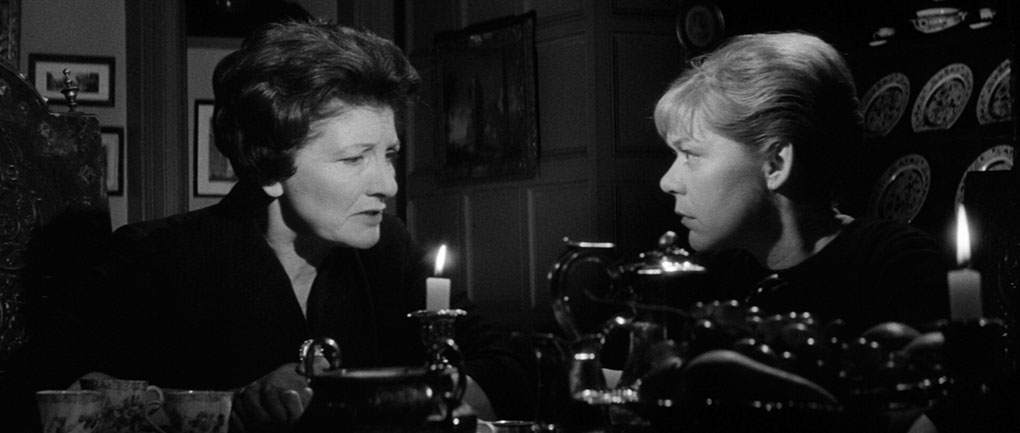
Any further discussion about the plot or characters risks spoiling some potential surprises for first-timers, so once again, if you’ve not seen the film and do not want to know more in advance (recommended, but not essential here), then hop ahead to the final paragraph of the review or click here to do so automatically. I’ll be avoiding spoilers for the second half of the film, but may end up giving a couple of things away, and that’s something to be ready for if you are staying with me.
If you know your horror-tinged psychological thrillers then there’s a good chance you’ll guess what’s going on here, but it’s a tribute to Hammer’s most consistently inventive screenwriter, Jimmy Sangster, that even if you do then you’re still likely to be wrong-footed, particularly when the big revelation comes far earlier than you would normally expect. And while the film was clearly influenced (again) by Henri-Georges Clouzot’s masterful Les Diabloques, the nightmare-of-the-title manner in which the film begins in some ways pre-empts the opening scene of Wes Craven’s A Nightmare on Elm Street. That someone may be staging these ghostly apparitions to drive Janet mad certainly seems likely, but what’s interesting is that no serious clues are dropped regarding who might be behind it, or indeed if this is a plot at all. There were moments when I became suspicious of individual characters, only to then be convinced that I was wrong by their facial expression after Janet has left the room, a moment that you would normally expect any façade staged purely for her benefit to slip. If this mystery has an initial weak spot it lies in David Knight as Henry Baxter, a late arrival in the story who although very good in the role, also rather neatly fits the profile of a self-confidently slick schemer, though in common with the other occupants of the house, he never does or says anything that you could specifically label as suspicious. And maybe, just maybe, he’s a carefully crafted red herring. Indeed, the only moment involving him in the film’s half that gave me a start is not something he does but something that’s done to him. When he first arrives back at the house and finds Janet in bed, he greets her warmly and goes to plant a fatherly peck on her forehead, only to have Janet grasp his head and firmly kiss him on the lips, an action that clearly surprises him and that he quickly breaks free from. Curiously, while this seems to be leading to an interesting and possibly even boundary-testing story strand, it’s never subsequently built upon or even referenced again.
Despite having pieced together some of the mystery, I couldn’t for the life of me come up with a convincing motivation for any attempt to convince Janet that she’s following in the footsteps of her mother and is losing her mind. When the revelatory twist comes, I was genuinely caught out and left wondering where a film with 40 minutes left of its running time could possibly go next. This leads to a second half that also keeps you guessing, directly echoing the first-half mystery – most viewers should be able to deduce what is going on, but not necessarily who is responsible or, once again, how it will ultimately play out.
Shot atmospherically in shadow-peppered monochrome and CinemaScope (or Hammerscope, as the studio would have it) by John Wilcox in his first of several genre films for the studio, built around a typically smart and well-structured script by Jimmy Sangster, and tightly directed by cinematographer-turned-director and Hammer favourite Freddie Francis, Nightmare is another entertaining and inventive example of Hammer’s sometimes under-appreciated psychological thrillers. A committed and talented cast helps to sell it, and while the news that Julie Christie was originally cast as Janet before pulling out for a plum role in John Schlesinger's Billy Liar does intrigue, I can’t imagine her doing a better job than Jenny Linden does here, though in the second half she’s given a serious run for her money by Moira Redmond’s sometimes fiery performance as Grace. And while the plausibility of the plan that most will realised is unfolding at an early stage does raise a whole host of questions, they were not ones that I found myself asking as this tense and tightly-wound story steadily builds to its rather satisfying final reveal.
Sourced from Universal’s HD master, the 2.35:1, 1080p transfer here is once again a bang-up job, boasting well-defined detail and a nicely balanced contrast range that shines in the brighter scenes, while the shadows and the darkness of night boast the sort of deep black levels that you can imagine just about anything hiding in, something that director Freddie Francis and cinematographer John Wilcox put to unsettling use. The image is clean and stable and a fine film grain is visible.
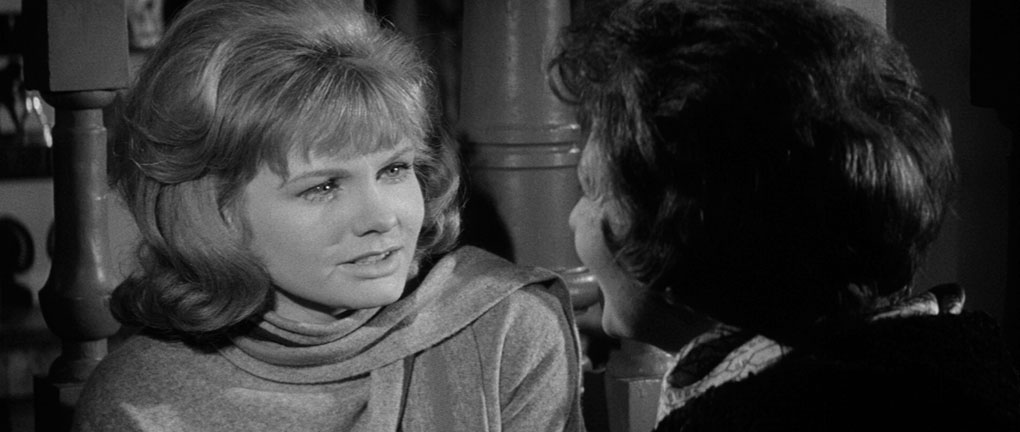
One small peculiarity of the image here is that when individuals are photographed in close-up, particularly if centre framed, they sometimes feel a just little horizontally stretched. This is not a fault of the transfer but apparently a quirk of the Bausch & Lomb CinemaScope lenses that were used during the 1950s and early 60s and which gave rise to the term ‘the CinemaScope mumps’. I have little doubt that some dedicated restoration house with unlimited time, money and resources could correct this frankly minor distortion, but this was how the film was shot and is thus how it should rightfully be presented, and it’s never a significant distraction.
The Linear PCM 1.0 mono soundtrack has also been remastered, and despite the expected range restrictions, is clear and free of obvious wear, and it handles the music score well.
Once again, optional English subtitles are included for the deaf and hearing impaired.
Audio Commentary with Kevin Lyons and Jonathan Rigby
The always welcome and knowledgeable Kevin Lyons and Jonathan Rigby deliver a commentary packed with information and astute observations on a film they both regard as one of the best in Hammer’s psychological horror cycle. They praise the direction and photography in the nightmare scenes and the use of lighting changes for transitions, provide considerable detail on the lives and careers of the actors, read out derogatory comments written by James Carreras on his copy of Jimmy Sangster’s script, and suggest some interesting connections to other films, only one of which I thought was a bit of a stretch. Hearing what Sangster’s plot-spoiling, spoof-sounding working title was for the film makes me glad that Carreras insisted on Nightmare, and there are shout-outs here for director Freddie Francis, the performances, score composer Don Banks, and cinematographer John Wilcox’s use of the scope frame. Both men react with horror at the doll Janet seems so attached to, read extracts from a few dismissive reviews and a very positive one from The Times that compares Freddie Francis to Mario Bava, and are as startled as I was by the fact that press materials used to list the addresses and phone numbers of the filmmakers and performers. A terrific commentary.
The BEHP Interview with Freddie Francis (82:14)
An audio-only (it plays as a second commentary track under the film) British Entertainment History Project interview with cinematographer and director Freddie Francis, conducted by Alan Lawson and Syd Wilson on 24 November 1993 and 6 June 1994. As tends to be the way with the BEHP interviews, Lawson and Wilson steer Francis through his entire film career, from his early days as a photographer’s apprentice through his pre-war film work and his time in what became the War Film Unit, to his post-war films as a cinematographer for directors like Joseph Losey, John Huston, Jack Clayton and Carol Reed. He talks about his films as a director for Hammer, but while he admits to having enjoyed working for the studio, he later claims that the only thing he would have done differently in his career was to stay away from horror. He holds his cinematography for Jack Clayton’s The Innocents in particularly high regard (no arguments here), enjoyed working for David Lynch on The Elephant Man, and provides some detailed information on a piece of camera equipment that was known as the Lightflex and later became the Varicon. I’m just scratching the surface here – Francis is an energetic speaker and covers a huge amount of ground, all of it enthralling.
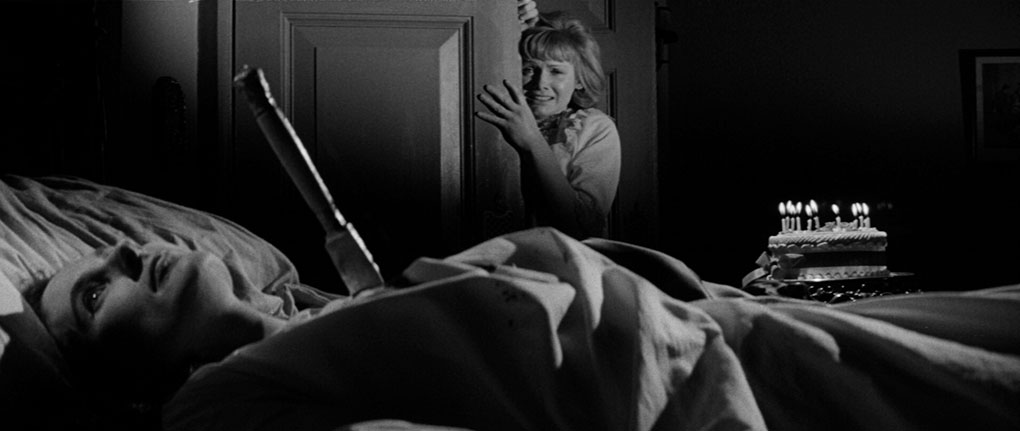
Jennie Linden: Memories (14:15)
An interview with lead actor Jennie Linden, conducted in her Isle of Wight home by Portia Booroff, in which she talks about her journey into acting via drama school and her subsequent career. For me, the most interesting segment is when she talks about taking six months off from acting to take care of her of her new child, which meant repeatedly turning down Ken Russell and a key role in Women in Love, only to be tracked down by Russell and his producers and told that she had been cast regardless and informed when she was to report for duty. Oddly directed – Booroff is filmed in medium close-up with Linden too often viewed from a distance, and the 180 degree rule is completely disregarded – and Booroff sometimes reads the questions in the manner of someone who’s only just been handed them, but the content is interesting enough to compensate for these quirks.
Hammer’s Women: Moira Redmond (10:02)
Critic and film historian Pamela Hutchinson looks back at the remarkable career of actor Moira Redmond, with coverage of her successful theatrical and television work and particular focus on her roles in Doctor in Love (1960), Nightmare and Jigsaw (1962).
Introduction by Kim Newman (8:10)
Here Newman places the film in the context of Hammer’s cycle of psychological thrillers and notes that writers like Sangster were aware that audiences were starting to suss the twists, so would get creative with the formula to still catch them out. He briefly discusses the horror directing career of Freddie Francis, praises Jennie Linden’s central performance, and highlights the contribution and brief filmography of Clytie Jessop.
Something Lurking in the Chords: Huckvale on Banks (29:48)
Opening with a friendly warning that there are significant plot spoilers ahead, this final contribution from David Huckvale sees him focus almost solely on examining and deconstructing the key elements of Don Banks’ wonderfully eerie score, often in considerable detail. He also has one of Banks’ original manuscripts, complete with handwritten notes, and reminds us that back then these people were composers who also did film scores, while today they tend to be one or the other.
Madhouse: Inside Hammer’s ‘Nightmare’ (14:12)
The commentary’s Kevin Lyons and Johnathan Rigby, together with The Hammer Story author Alan Barnes and cultural historian John J. Johnston, examine a film they all seem to regard rather highly, though in doing so they assume you’ve watched the film beforehand, as there are major spoilers here for the uninitiated. Areas covered include the film’s structure, its position in Hammer’s cycle of psychological thrillers, the influence of Psycho on a high angle shot, Jennie Linden’s performance, and more.
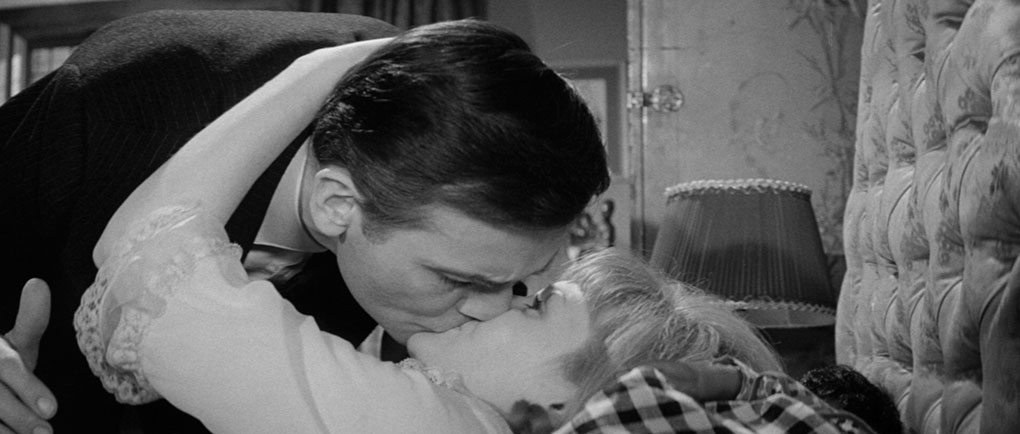
‘Nightmare’ in the Making (27:14)
A look at the making and release of Nightmare, hosted by Wayne Kinsey, who may not be the world’s sparkiest presenter, but his expertise in all things Hammer is beyond question. How informative this documentary short will prove to be will depend in part on the order in which you watched the special features, as by the time I got to it, some of its thunder had been stolen by the Rigby/Lyons commentary, the Kim Newman introduction, and the Madhouse featurette. That said, this does include further extracts from the above-detailed interview with actor Jennie Linden, who here talks about landing the role, her working relationship with her fellow actors and director Freddie Francis, the initial casting of Julie Christie, and more. There are also interview snippets with art director Don Mingaye, screenwriter Jimmy Sangster, and the met-at-Hammer couple of assistant director Hugh Harlow and script supervisor Pauline Wise (now Harlow). Definitely worth seeing, but I have to take issue with Kinsey’s claim that Brenda Bruce was the ‘star’ of Michael Powell’s Peeping Tom – her character is killed off fewer than three minutes into the film.
Theatrical Trailer (1:03)
A rather ramshackle trailer with a lurid narrator, who signs off with the echoed proclamation, “Shocking! Shocking! Shocking!”
Image Galleries
Sticking with the format of the other three discs, the first gallery consists of 43 Production Stills – including two that have been hand-coloured less garishly than British lobby cards of the period – a handful of posed portraits and a single behind-the-scenes shot. Promotional Material feature 42 screens of press images, psychedelic lobby cards, press book pages and posters, including one for a double bill with The Evil of Frankenstein.
Booklet
The final booklet in the set features a persuasive and thoughtful appreciation of the film by author and film writer Emma Westwood, one whose closing line made me laugh out loud. Extracts from Hammer’s publicity material on the film’s cast are followed by the now expected extracts from the American pressbook offering suggestions on ways to exploit the film, which include the William Castle-like notion of planting ‘screamers’ in the audience during opening night screenings. Also from the pressbook is a piece in which screenwriter Jimmy Sangster discusses his formula for creating a successful screenplay, which in the sampling of contemporary critical responses, Monthly Film Bulletin is back to having a dig, both at the plot’s predictability (do me a favour) and what it seems to regard as Hammer’s least impressive recruit, a certain Oliver Reed, who was soon to become a major star. As ever, full credits for the film are included and the booklet is handsomely produced and illustrated.
What more to say? Another excellent and feature-rich collection of lesser-seen Hammer films from Indicator and in my view one of the best yet, for the consistent quality of the films, the superb presentation and the plethora of quality special features. Indeed, it’s the sheer volume of supporting material for each film that is responsible for the repetition of some information, but you’ll not find me complaining. A brilliant set, very highly recommended.
|